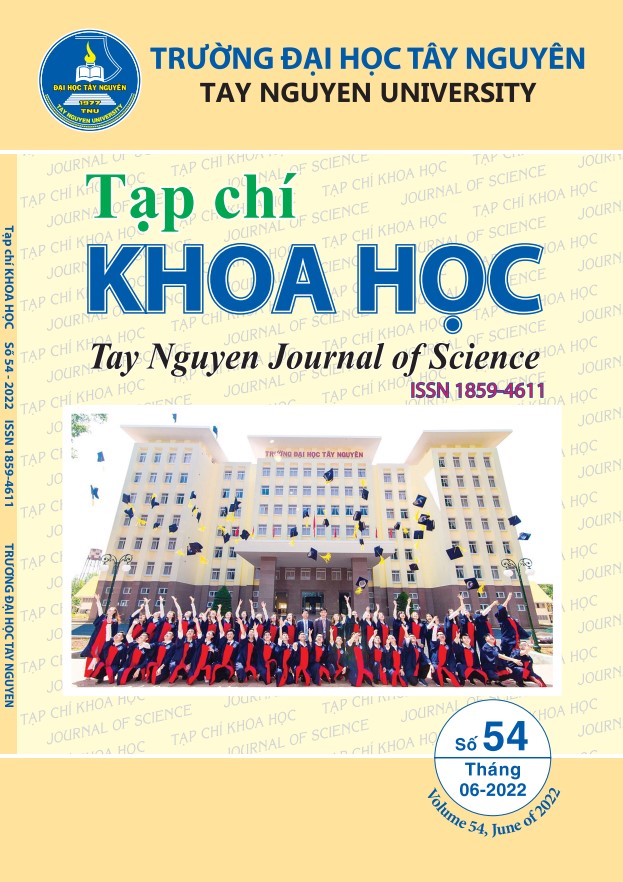Ảnh hưởng của phân bón sinh học Ami Ami α đến cộng đồng vi sinh vật, tuyến trùng và độ phì của đất trồng hồ tiêu (Piper nigrum L.)
Main Article Content
Ảnh hưởng của phân bón sinh học Ami Ami α đến cộng đồng vi sinh vật, tuyến trùng và độ phì của đất trồng hồ tiêu (Piper nigrum L.)
Tóm tắt
Nghiên cứu ảnh hưởng của phân bón sinh học AMI AMI α được thực hiện trên cây hồ tiêu giống Vĩnh Linh tại tỉnh Đắk Lắk từ năm 2017 - 2020. AMI AMI α được sử dụng với liều từ 100 - 120% theo lượng N của quy trình khuyến cáo, có bổ sung P và K, Mg và một số vi lượng khác. Sau 4 năm nghiên cứu, kết quả cho thấy ở các công thức bón 4,68 lít AMI-AMI α, bổ sung 0,1kg KCl/trụ (CT3) và bón 4,68 lít AMI-AMI α, bổ sung 0,1kg KCl/trụ kết hợp phun 0,5% MgSO4 (CT4) có mật độ vi sinh vật tổng số tăng 39,3%, vi sinh vật cố định đạm tăng 38%, vi sinh vật phân giải phosphat khó tan tăng tới 153%, mật độ vi sinh vật phân huỷ cellulose tăng 48,4%; trong khi đó mật độ Fusarium spp. trung bình giảm 35%; Phytophthora spp. giảm 52%; tuyến trùng trong rễ giảm 49,3% và tuyến trùng trong đất giảm 56% so với công thức đối chứng cùng thời điểm. So với thời điểm trước bón phân (2017), mật độ vi sinh vật tổng số, vi sinh vật cố định N, phân giải P và Cellulose tăng 10 - 15%, mật độ nấm Fusarium spp. Trong đất giảm 14,44%; Phytophthora spp. giảm 14,53%; tuyến trùng trong rễ giảm 24% và tuyến trùng trong đất giảm 18,39%. Trong khi đó, ở công thức đối chứng chủ yếu sử dụng phân hóa học có mật độ vi sinh vật tổng số và nhóm vi sinh vật có lợi là cố định N, phân giải phosphat khó tan và phân giải cellulose đều giảm 22%; trong khi đó mật độ Fusarium spp. tăng 24,6%, Phytophthora spp. tăng 218% và mật số tuyến trùng tổng số trong đất tăng 72,8%. Các kết quả cho thấy phân bón sinh học AMI AMI α làm gia tăng vi sinh vật tổng số, nhóm vi sinh vật có lợi và hạn chế sự phát triển của nhóm nấm bệnh và tuyến trùng. Phân bón sinh học AMI AMI α có tiềm năng sử dụng cho canh tác hồ tiêu theo hướng hữu cơ và bền vững môi trường.
Article Details
Tài liệu tham khảo
- Bộ Công Thương (2019). Bản tin thị trường Nông lâm Thủy sản, số ra ngày 31/12/2019, Thị trường hạt tiêu, 18-24.
- Burgess L. W, Summerell B. A., S. Bullock, Gott K. P. and Backhouse D. (1994). Fusarium research. 3rd edition. University of Sydney.
- Chu H, Lin, X.; Fujii, T., Morimoto, S., Yagi, K., Hu, J. and Zhang, J. (2007). Soil microbial biomass, dehydrogenase activity, bacterial community structure in response to long-term fertilizer management. Soil Biology & Biochemistry 39, 2971-2976.
- Erwin, D.C. and Riberrio O.K (1996). “Phytophthora diseases worldwide”, St Paul, Minnessota, USA, American Phytopathological Society Press, 562 pp.
- Gravel, V., Ménard, C. and Dorais, M. (2009). Pythium root rot and growth responses of organically grow geranium plants to beneficial microorganisms. Hort Science: 44(6):1622-1627. Griffiths.
- B.S., Philippot L. (2013). Insights into the resistance and resilience of the soil microbial community. FEMS Microbiol Rev 37:112–129.
- Krishnakumar S., Saravanan, A., Natarajan, S.K., Veerabadran, V. and Mani, S. (2005). Microbial population and enzymatic activity as influenced by organic farming. Res. J. Agric. & Biol. Sci. 1(1): 85-88, 2005.
- Lugtenberg, B.; Kamilova, F. (2009). Plant-growth promoting rhizobacteria. Annu Rev Microbiol, 63:541-556.
- Manici M., F. Caputo and V. Babini. (2004). Effect of green manure on Pythium spp. population and microbial communities in intensive cropping systems. Plant and Soil. Volume 263, Number 1 (2004), 133-142.
- Melero, S., J., Porras, CR., Herencia, J.F and Madejon, E. (2005). Chemical and biochemical properties in a silty loam soil under conventional and organic management. Soil Till. Res., 90, 162-170.
- Ngo, VA., Wang, S.L., Nguyen, VB., Doan, CT., Tran, T.N., Tran, MD., Tran, TD., Nguyen, AD. (2020). Phytophthora antagonism of endophytic bacteria isolated from roots of black pepper (Piper nigrum L.), Agronomy 10 (2), 286.
- Nguyen, TH., Nguyen, AD., Vinh, QV (2020). Biodiversity of soil microorganisms and their effects on disease management at black pepper farms in Gia Lai province, Asian Journal of Biology, 1-11.
- Nguyen, DS., Trinh, THT., Tran, TD., Nguyen, TV., Chuyen, HV., Ngo, VA., Anh Dzung Nguyen (2021). Combined application of rhizosphere bacteria with endophytic bacteria suppresses root diseases and increases productivity of black pepper (Piper nigrum L.), Agriculture , 11 (1), 15.
- Nielsen, P.; Sorensen, J. (1997). Multi-target and medium-independent fungal antagonism by hydrolytic enzymes in Paenibacillus polymyxa and Bacillus pumilus strains from barley rhizosphere. FEMS microbial. Ecol., 22, 183-192.
- Perez-Piqueres A, V. Edel-Hermann, C. Alabouvette and Steinberg, C. (2006). Response of soil microbial communities to compost amendments. Soil Biology & Biochemistry 38, 460-470. Soil Enzymes, Academic Press, London, pp. 51–56. Southey JF. Laboratory methods for work with plant and soil nematodes. 1986; 402. HMSO, London.
- Tran, TPH, Wang, SL., Nguyen, VB., Nguyen, AD. (2019). Study of novel endophytic bacteria for biocontrol of black pepper root-knot nematodes in the Central Highlands of Vietnam, Agronomy, 9(11), 714.
- Trinh, THT, Nguyen, VB., Doan, CT., Nguyen, AD (2019). A potent antifungal rhizobacteria Bacillus velezensis RB.DS29 isolated from black pepper (Piper nigrum L.), Research on Chemical Intermediate, Springer, 45, 5309–5323.



